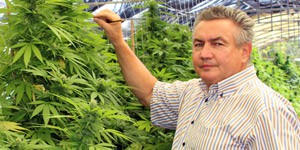By Sarah Russo

Sarah Russo is a writer, cannabis consultant, and a social media and content manager. She got her degree in environmental studies and social justice, with a focus in plant medicine from the Evergreen State College. She has previously worked for Project CBD and the Society of Cannabis Clinicians. She has also acted as an herbal medicine educator in natural remedy apothecary shops. Some of her main goals are diversifying the cannabis movement by integrating the plant into the greater herbal medicine compendium as well as encouraging sustainable agricultural practices.
Meet the Experts is a series of interviews conducted by experts from the field of Cannabis to world leaders in research and clinical practice of Cannabis as medicine.
Dr. Ziva Cooper researches the effects of psychoactive substances in the human laboratory using double-blind, placebo controlled methods. Her work, funded by the NIH and industry, focuses on understanding biological and behavioral factors that influence both the therapeutic and adverse effects of cannabis, cannabinoids (the chemical constituents of the cannabis plant), opioids, and cocaine.
She consults for organizations ranging from the California Department of Public Health to the National Football League (NFL) on the science of cannabis-related health effects. An Associate Professor of Neurobiology in Psychiatry at Columbia University Medical Center, Dr. Cooper was a co-author of the National Academies of Sciences consensus report on the Health Effects of Cannabis, is President of the International Study Group Investigating Drugs as Reinforcers, a Board Director for the College on Problems of Drug Dependence, and is an Associate Editor of The American Journal of Drug and Alcohol Abuse, and is on Editorial Boards of journals including Cannabis and Cannabinoid Research.

Sarah Russo: How is studying the abuse potential of cannabis different to other substances? Does a user ever experience withdrawal when they stop using cannabis?
Ziva Cooper: With any therapeutic or substance, it is always important to address both its benefits and risks. The same is true for cannabis and cannabinoids. Many people recognize that cannabis could potentially lead to a use disorder. In the USA, we have the DSM 5 which classifies Cannabis Use Disorder (CUD) as a diagnosis, as well as alcohol, tobacco, opioid, and stimulant (i.e., cocaine) use disorders. CUD occurs in only a small fraction of people, it is estimated to be that about 1 in 10 may develop a use disorder. Some people who develop CUD actually want to stop using cannabis, maybe because it is interfering with their professional or personal lives, or having negative physical effects, but they have a hard time abstaining. This is an issue because as of now, we don't have a good pharmacotherapy to treat those who want to stop using cannabis. Some of the hallmark signs of CUD is an increased need to use more in order to achieve the same desired effect (tolerance) and withdrawal when one abstains.
THC has been identified as the component of the cannabis plant responsible for producing dependence. Interestingly, if someone is a daily smoker and uses quite a bit each day, they won't likely come into contact with withdrawal symptoms. This is because THC is lipophilic (binds to fat cells), so it leaves the body very slowly. As such, withdrawal doesn't usually start to occur until a day after someone stops using, and doesn't peak until around 3 days later. Signs of cannabis withdrawal include anxiety, irritability, and mood disruptions. Some other issues include a decrease in appetite and disrupted sleep.
The clinical significance of CUD or cannabis withdrawal has been compared to nicotine dependence. It should be noted that much of our knowledge on cannabis withdrawal symptoms is based on seminal studies by Dr. Meg Haney at Columbia University. These very controlled studies were done with cannabis from the University of Mississippi (NIDA cannabis) that contained up to 7% THC, much lower strengths than what is typically available at cannabis dispensaries in the US and Europe today, which can have concentration up to 25% THC. We are only able to get our research cannabis from that one source. We have yet to know how some of the newer cannabis products that are available, including high strength cannabis and extracts, affect withdrawal symptom severity. One hypothesizes that these products could lead to withdrawal symptoms that are more severe in magnitude. This has to be researched, but we need the material in order to be able to study those endpoints.
As of now, we don't have an FDA approved medicine for CUD yet. Research spearheaded by Meg Haney has examined laboratory models to identify potential pharmacotherapies for cannabis withdrawal and relapse. We have people live in a residential facility and observe withdrawal over time when participants are abstinent. Using a laboratory model of cannabis relapse, we can assess the impact of withdrawal on the likelihood of relapse during abstinence. We use this model to determine if a potential pharmacotherapy for CUD can both reduce withdrawal symptoms and likelihood of relapse.
One of the medications that has been shown to be beneficial in decreasing cannabis withdrawal and relapse is a drug called nabilone. Nabilone, an FDA approved medication for certain indications including chemotherapy induced nausea and vomiting, is very similar to THC as it's a cannabinoid receptor 1 (CB1) agonist. Dr. Haney found that nabilone decreased withdrawal symptoms during abstinence from cannabis and also decreased relapse behavior. Because nabilone is a CB1 agonist like THC, this would be considered an agonist replacement therapy. These types of pharmacotherapies have shown promise with opioid use disorder, too, so there's strong rationale to using this strategy for cannabis use disorders. This study was done in a small group of non-seeking cannabis treatment users. The next step would be to look at a larger group in people who want treatment for cannabis use disorder.
SR: Could you share a bit about your double-blind, placebo-controlled, human study on cannabis and its ability to enhances the pain relieving properties of low dose oxycodone? How was this unique to other studies?
ZC: There has been a lot of discussion on cannabis's potential to alleviate the opioid crisis in the USA. According to preclinical literature in animal models, it appears that when THC (or compounds that act at the CB1 receptor) is combined with an opioid, it produces a synergistic effect. That means that a combination of small dose of cannabinoids and opioids could produce robust pain relieving properties. In these models, while analgesia increased when the combination was administered, opioid abuse liability did not, an important variable to consider when determining if the drug combination has clinical utility.
There have also been encouraging state-level findings where a reduction in opioid prescriptions and fatalities were observed in states with medical cannabis laws. However, it's important to remember that these findings are associations, not causation. We cannot say that because medical cannabis was legal in those states, it caused the decrease in opioid fatalities or use. There are several other factors that may be at play and contributed to the reductions in opioid use. In order to address causation, we sought to directly determine if cannabis could potentially decrease the need for opioids for pain by doing a rigorous, double blind, placebo controlled study in the laboratory.
This was the first and only study (thus far) that investigated the ability of cannabis to reduce the dose of an opioid needed to reduce pain relief under controlled conditions. Our study combined cannabis and oxycodone, a popularly used and abused opioid. Since we wanted to maximize experimental control, we tested how the drug combination would impact pain response using an experimental pain test. As such, participants did not have current pain, nor were they on any type of medications, which were two factors that could potentially interfere with outcomes.
To study the participant's pain response, we used the cold pressor test, a standard laboratory pain model. People put their hand in ice cold water and were asked to report when they first felt discomfort. When the pain became no longer bearable, they removed their hand from the water. Even though this is an acute pain test, the cold pressor test is known to predict which medications are best for chronic pain in the clinic.
Another important aspect to the study was that we also assessed the impact of the drug combination on levels of intoxication and abuse liability; two drug effects that are undesirable when assessing a therapeutic for its clinical utility.
Participants came into our lab over six visits, and each person underwent each of the different drug conditions. We assessed the analgesic effects of smoked cannabis with 6% THC alone, and two strengths of oxycodone alone; the lowest effective dose (5 mg) and half of the effective dose (2.5 mg) We then assessed the pain relieving effects when cannabis and oxycodone were administered together. Lastly, pain responsivity was assessed when participants received placebo cannabis (0% THC) and placebo oxycodone (0 mg). Based on the preclinical animal findings demonstrating opioid-cannabinoid synergy, we expected that while the lowest dose of oxycodone (2.5 mg) would fail to produce pain relief on its own, when taken with cannabis, we would observe robust analgesia.
When we combined smoked cannabis and oxycodone, we found a significant increase in the pain relieving effects compared to when they were administered alone, and the combination produced only modest increases on some measures of abuse liability.
Our follow up study will assess different whole plant cannabis chemovars vs. placebo in conjunction with low dose oxycodone. Cannabis will be vaporized, rather than smoked, which is more preferable for therapeutic purposes. We will examine cannabis with CBD and no THC, a combination of 1:1 THC/CBD, and CBD dominant, low THC cannabis varieties and their impact on pain response. Our hypothesis is that CBD may potentially decrease the intoxicating effects of THC and boost the pain relieving effects of oxycodone. This is an important area to address because there is a lot of discussion related to CBD's potential for pain relief and its potential to decrease opioid abuse liability.
SR: Does gender play a role in different ways people can respond to cannabis?
ZC: It is a very interesting time to study sex effects because historically, being female has been a protective factor in the initiation of cannabis use and the development of CUD. Males outnumber females 2:1 for cannabis use initiation, regular use, and the development of CUD. However, over the last several years there has been an increase in number of females who are seeking out cannabis for medicinal use, especially for pain. Is it possible that women are turning to cannabis for medical purposes at a higher rate because it is more effective for them? Preclinical animal findings have repeatedly shown that females are more sensitive to the pain relieving properties of CB1 receptor agonists than males. It is important to understand if these effects translate to humans.
SR: When assessing the therapeutic effects of cannabis, what are some important variables to keep in mind?
ZC: It is critical that we examine both the therapeutic and adverse effects (such as intoxication) over a range of doses and across different modes of administration. By assessing the impact of dose and route of administration we will be able to find a way to maximize the therapeutic effects of cannabis and cannabinoids while also mitigating the adverse effects. Additionally, investigating a range of cannabinoids, not just THC, alone and in combination may also prove to be a helpful strategy in maximizing the clinical utility of cannabis.
SR: What are areas of cannabis investigation do you feel like deserve more focus?
ZC: More research is needed for cannabinoids other than THC. It is clear that THC has a great deal of clinical potential, but the intoxication factor will negatively impact its therapeutic utility. CBD is of significant interest given the robust preclinical studies supporting its therapeutic use, but it hasn't been studied in the clinic to the extent that it needs to be. Apart from its effects on pediatric epilepsy, there have been few rigorously controlled studies that have probed its efficacy. I expect that over the next ten years we will see tremendous growth in this area of research.
Other cannabinoids like THCV, CBDV, CBDA, are also important to investigate. We know very little about their effects, even in laboratory animal studies. The idea of the entourage effect, that a combination of terpenes, flavonoids, and cannabinoids are more beneficial than cannabinoid isolates, is important to examine. There is support for the entourage effect, but we have yet to look at it under rigorous double blind, placebo controlled study procedures. I am hopeful that we will see a lot of interesting work in this area within the next several years.
SR: Thank you, Ziva.


